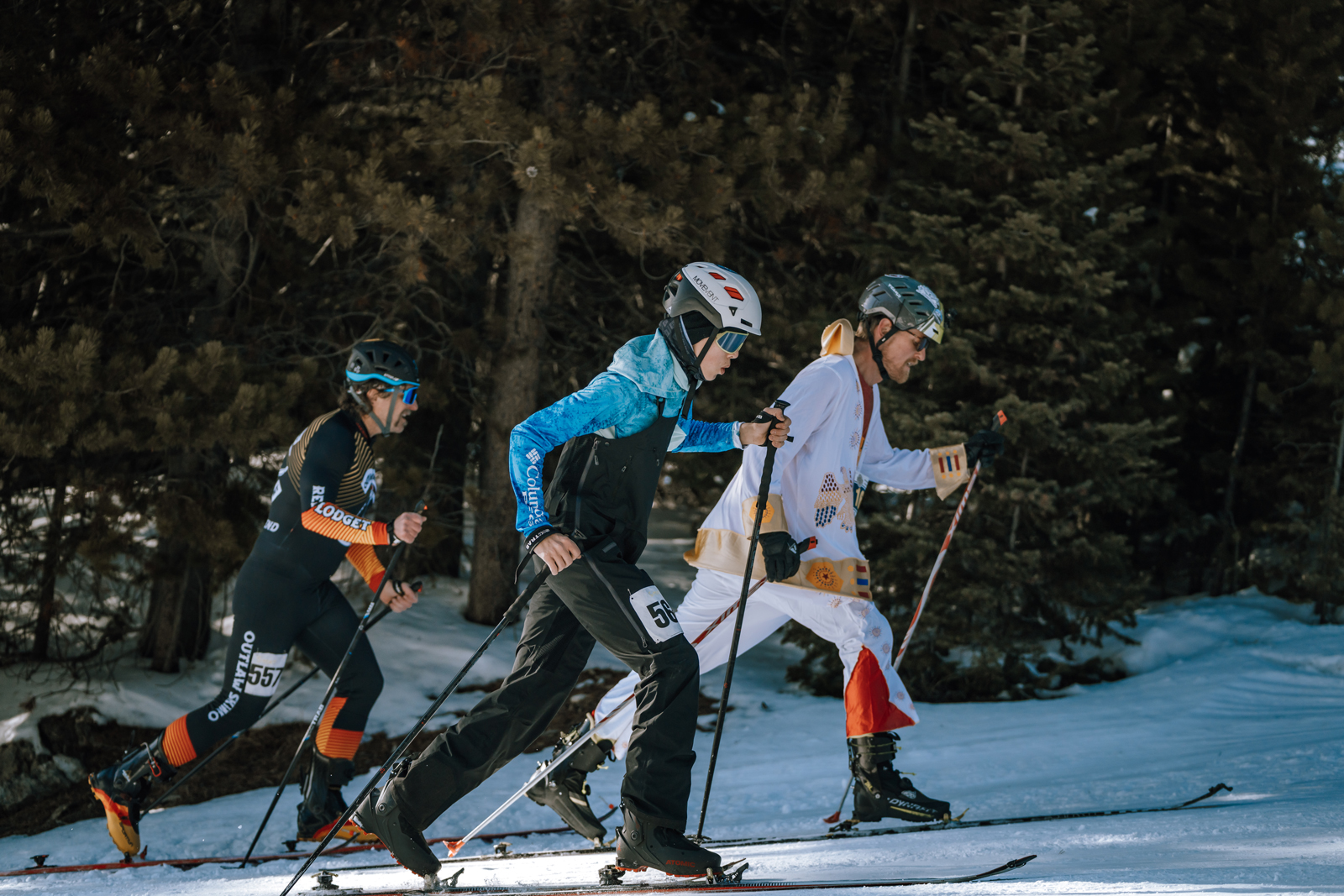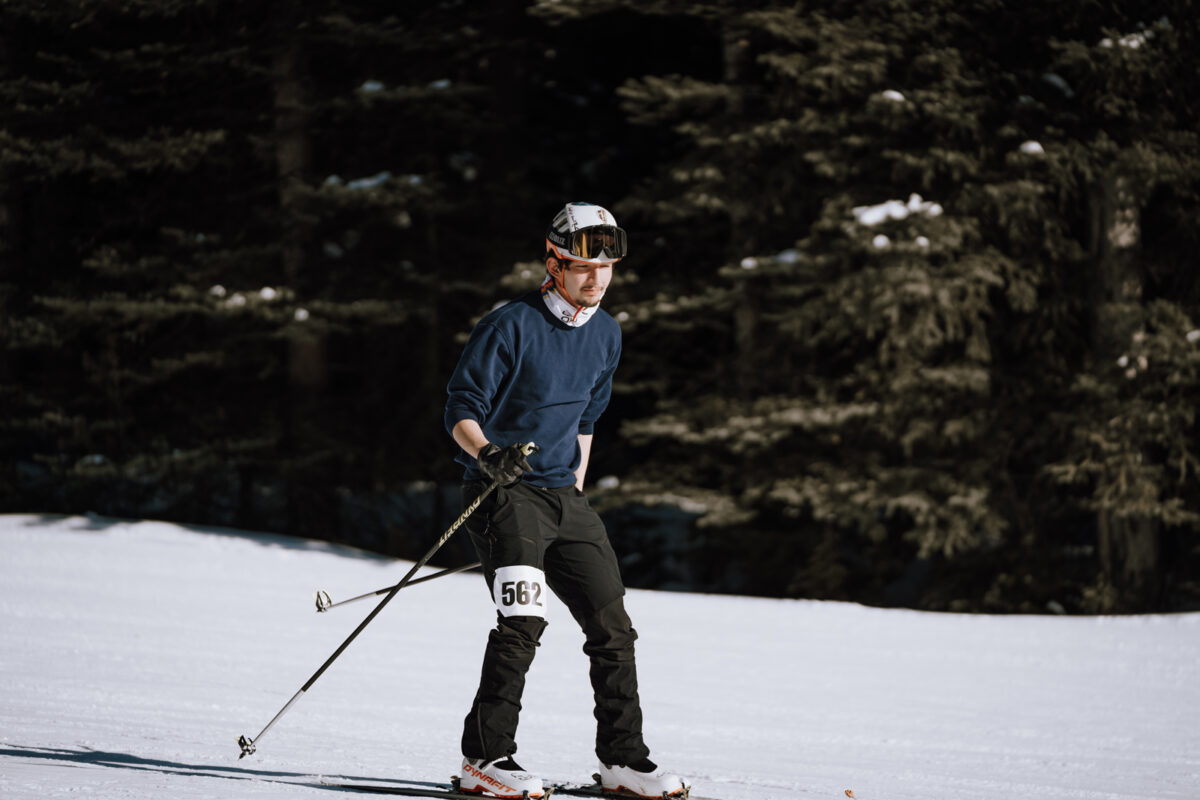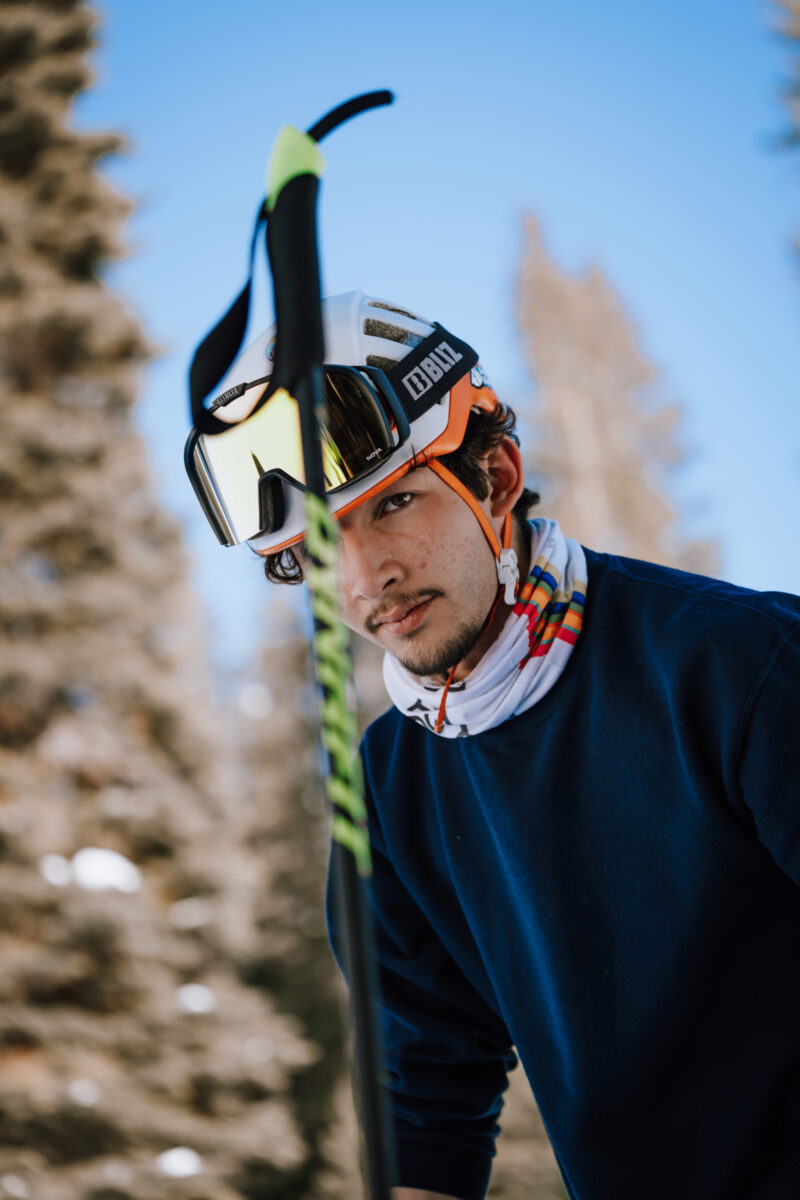Blackfeet Youth Take on Uphill Challenge in Big Sky Skimo Cup
Indigenous Ascent Coalition teamed up with the Big Sky Skimo Cup to introduce Browning High School students to the world of competitive ski mountaineering
By Micah Drew
At the top of Claim Jumper, a groomed blue run on the front side of Discovery Ski Area overlooking Georgetown Lake, a group of skimo athletes milled around catching their breath. Sporting a mixture of spandex race suits, jorts and costumes, the skiers had just completed the vertical ascent at the Jack ‘n Jill Randonnee Race, a European-style ski mountaineering competition.
Missoula’s Jeff Mogavero had finished the 1,100-foot climb in 19 minutes flat, followed closely by the rest of Montana’s top skimo racers, including several who competed at the U.S. Championships the first weekend in March.
As the afternoon light slowly faded, the group continued to cheer on each additional athlete who completed the lung-wrenching, energy-sapping climb up the mountain.
Just past the half-hour mark, 18-year-old Sam Gordon appeared over the crest, his face caked in blood. His snow pants were held up by a leather belt and he was half-gliding, half-lurching towards the finish line. One of his climbing skins, which normally attaches to the bottom of a ski giving a skier traction to move uphill, was clenched in his left fist.
Gordon, a senior at Browning High School, crossed the line and took a deep breath as Joel Shehan, a veteran racer from Whitefish, skied over to exchange high-fives and offer congratulations.
“My skin came off just in the last minute and I didn’t know what else to do,” Gordon said with some disappointment. “Man, was that hard.”
The blood turned out to be from a spontaneous bloody nose, not related to falling when his skin slipped off his brand-new race skis. A few minutes later, Gordon realized he was wearing two similar, but different skis on either foot, adding to the difficulty of his climb.
But it didn’t matter. He’d completed his first-ever skimo race, just weeks after first learning that the sport existed. And he was stoked.

Bringing up the rear of the racing field on that same March afternoon, 15-year-old Sheldon Meineke and 14-year-old Hayden Edwards, who, like Gordon, are Blackfeet tribal members and attend Browning High School, made their own ascent up the slope. Each descending racer paused as they passed to offer a tip on technique or shout words of encouragement as the two youths neared the top.
Meineke, Edwards and Gordon are part of the Indigenous Ascent Coalition skimo team, a new initiative started by Nicole Edwards, owner of Rising Wolf Outfitters in East Glacier, and Matt Madsen, who founded the Big Sky Skimo Cup, which culminated in the Jack ‘n Jill race at Discovery.
Nicole Edwards, a Blackfeet tribal member who grew up on the Blackfeet Reservation and opened Rising Wolf Outfitters in 2021 after a decade working in the tech sector, has always envisioned forging new pathways for Indigenous youth to get into the wilderness.
“My whole goal as an outfitter was to use it as a platform to get kids out into the mountains, especially Indigenous kids on the reservation,” said Edwards, who founded a nonprofit arm of her company, Indigenous Ascent Coalition, this winter. “We have Glacier right there, but not many local kids have the resources to access the park and access the mountains. This winter I wanted to prioritize making that happen.”
Matt Madsen lives in Bozeman and has organized the Big Sky Skimo cup for three years as a way to build the skimo community across the state. The cup is a series of races held across the state throughout the winter, culminating in Jack ‘n Jill, which serves as a de facto “state championship” event. As participation has surged and partnerships and sponsorships have increased, Madsen found himself with some extra funding available this winter and cast about for the best use.
“The Big Sky cup has always been about building community and trying to get more people into the world of skiing to show that it’s not just this intense thing, but it’s a fun community that anyone can be part of,” Madsen said. “I wanted to figure out how you can keep breaking down the barriers to entry.”
Through some mutual acquaintances, Madsen and Edwards connected and discussed the possibility of holding a seminar with middle school and high school kids from Browning to gauge interest in learning about the world of ski touring.
“I think that skimo could lead to a lot of opportunities for these kids,” Edwards said. “A lot of athletes come from the reservation, and lots of them are runners. They like the competitive parts of it and this is a nice parallel to that.”
Edwards held a well-attended informational session in February showcasing some of the gear used in traditional backcountry skiing, as well as skimo racing. Given the high degree of interest, that session paved the way for the next step — strapping on skis.
Madsen drove up to St. Mary the following week with more than a dozen pairs of skis, rented or loaned from friends, businesses and the Montana State University outdoor program to set up an exhibition and training course.
Fifteen kids from Browning came out for the in-person training day, many of whom had never been on skis before, much less short, skinny racing skis.
“It was just a super basic intro — learn to put skins on, hike around a little bit, ski a little bit,” he said. “But everyone was beyond excited.”
Beyond their interest in learning about a new sport, Edwards said that the kids were drawn to the idea of being part of a team activity.
“I told them to look around at the other kids, and understand that they were bonded. Even if you’re doing an individual race, you’re here to support each other and lift each other up,” she recalled. “Lots of good life lessons will come out of this, other than just opportunities for competition and opportunities to get into the mountains.”
Meineke said being out in the mountains is an important way to enhance his connection to the environment and Mother Nature, and he was quickly taken by the new modality. Of the group that showed up to the clinic, he, Gordon, and Hayden Edwards, Nicole’s niece, had the most prior experience skiing or snowboarding, and were interested in delving deeper into the new sport. Madsen and Nicole took them out for a second clinic, setting up a more challenging, albeit still mellow, skimo course to practice walking through some trees, executing some kick turns and running through a transition.
“They spent all of four hours just doing some basic drills and after that, they wanted to try a race,” Madsen said.
Ski mountaineering and backcountry skiing has long been a popular way for winter aficionados to push themselves to new heights and discover new lines and powder stashes beyond the boundaries of a ski resort.
In recent years, especially following the COVID-19 pandemic, the numbers of backcountry skiers spiked due to the socially distanced nature of the sport. Over the same time frame, skimo, the competitive form of ski mountaineering usually held in-bounds at ski resorts, also saw a boom in popularity.
In 2021, the International Olympic Committee announced that skimo racing would debut at the 2026 Olympic Games in Milano-Cortina, sparking a surge of media coverage and participation.
Even though uphill travel on skis eschews the use of chairlifts, and therefore ski passes, it is a gear-intensive, and therefore expensive, sport to get into, with full kits costing anywhere from a couple hundred to several thousand dollars.
CJ Carter, a skimo athlete from Bozeman who has raced at the international level, knows that the ski mountaineering world is out of reach to many underserved populations. Carter spent nearly a decade working for the Blackfeet Nation as a professional planner, focused on natural resource management. When he heard what Nicole, Madsen and Indigenous Ascent were brainstorming, he thought it made perfect sense.
“During the pandemic, there were a lot of conversations about how to get people outside. The tribe acquired a groomer and began grooming campgrounds at lower Two Medicine and ordered a whole set of cross-country skis. That started a whole conversation within the Tribe about starting a winter sports movement,” Carter said.
While working with the Tribe, Carter said he noticed how much the notion of racing is entwined into tribal DNA. “There’s such a legacy of foot racing and Indian relays — people really like to race,” he said. Melding the tribal connection to the mountains that make up the “backbone of the world” with an affinity for racing seemed natural.
“There’s a bit of a culture match where this kind of obscure sport has really deep roots in native traditions of skiing all around the world,” he said. “Bringing it full circle back to Indigenous communities is a way to really celebrate the sport and the way it connects communities to their landscape. Plus, anything that lights a spark with youth, especially Indigenous youth, it’s worth going full in on.”
Carter, who currently lives in Washington, was unable to make the trip back to Montana to help introduce the new segment of budding youth skimo participants to the sport. However, he decided to do what he could to crack open a barrier after realizing Gordon and Meineke were about the same size as him. Full sets of race gear — brand new and still boxed up — showed up for the young Blackfeet men to use just in time for the race.
“It was a no-brainer for me,” Carter said. “I hope it’s the beginning of a lifelong experience of moving through the winter environment on skis. The mountains in Blackfeet country are world class and these youth are profoundly connected to that. They deserve the investment to unlock the tremendous potential these kids have.”
“It’s really awesome he just wanted to send Sheldon and I stuff even though we’d barely learned what skimo was,” Gordon said. “One day, I want to be able to race with him, you know. It feels like the best way I could repay him for helping get us out here.”

“The kids are all for it. I don’t think they know what they’re getting themselves into, but they’re stoked,” Nicole said a few days before the race.
The Big Sky Skimo Cup state championship is usually held at Teton Pass Resort near Choteau, but after snow conditions forced that resort to close in mid-February, Discovery Ski Area offered to host. So, Edwards picked up the team from school on Friday and drove down to Phillipsburg in time for the first day of racing.
The Jack ‘n Jill Randonnee comprised an ascent race on Friday afternoon, followed by short, medium and long course individual races the next day, where racers made one, two or three climbs and descents around the mountain.
After their first experiences in the uphill race, Meineke and Hayden completed the short course, while Gordon opted for the medium course.

“It was a really big challenge, but I’m up for challenges and I’ve been having fun with this stuff,” Meineke said after his race. “Even though most people here are way more talented, it’s been really fun and it seems like something I would like to keep doing.”
Gordon didn’t have any issues with his equipment during his second race, and said he could see the improvement he’d made with just one additional day out on the snow.
“I definitely got more used to going downhill on these skinny skis, it’s so different than what I normally ski on,” he said. “And it was fun to do some of the technical parts of the course going through trees and doing a boot pack. I think I did it in a decent time, and I’ll just go up from here.”
Gordon was also surprised at the outpouring of support he’s seen in the few short weeks of his skimo season, from folks donating gear to those who just wanted to shake his hand after a race.
“It wasn’t just from people back on the res, but all the people in this skimo community,” Gordon said. “All the people waiting for us at the finish were really nice, they just wanted to say hi and talk about our experience out there.”
He plans to stick with the sport. While official, sanctioned sports are more popular choices for high schoolers, he’s confident he’ll be able to sell more local youth on skimo.
“After what people have done to help get me out here, hopefully I can erase that barrier for other people too,” Gordon added.
After recovering from the races — being handed a Discovery cookie at the finish line helps speed the process — the three racers and Nicole spent a few more hours on the hill, this time riding the chairlifts instead of hiking to the top. It wasn’t long before they started thinking about the next race, however.
“After the Disco trip, they wanted to go to Kicking Horse for [another skimo race] but we couldn’t come up with enough funding, unfortunately. I’ve never seen Hayden so stoked on a sport and she’s a champion wrestler!” Nicole said.
“As Native Americans, these mountains are our culture and they should be immersed in them,” she continued. “The plan for next winter is to build all of the backcountry skills into these kids, basic stuff you need to know to be in the mountains safely, because once you have the skills and know-how, you can always go out and be in the backcountry, and I want that for every youth here. But, the athletic, competitive side of things, that can sometimes be a bigger hook for younger kids, so I’m pretty sure we’ll be back with a much bigger team racing next year.”
Learn more about the mission of Indigenous Ascent Coalition and support the skimo team here.
An earlier version of this article misidentified CJ Carter as CJ Carpenter. We regret the error.